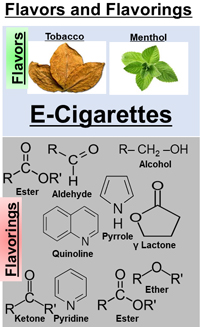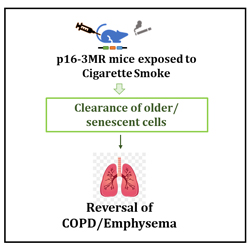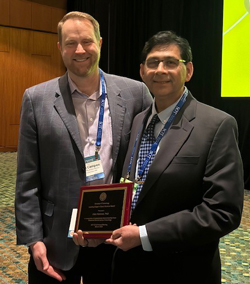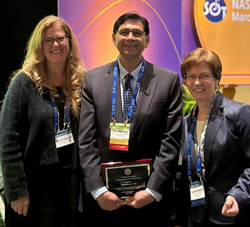Flavored Oral Nicotine Pouches as Chewing Gums – Interview by Irfan Rahman, PhD
Monday, November 27, 2023
ZYN Pouches Are Gaining Popularity—How Do They Compare to Smoking and Vaping?
ZYN pouches are growing in popularity, and it could be a problem.
There are multiple brands of nicotine pouches, but ZYN has recently exploded on platforms like TikTok, with videos on the topic garnering 292.6 million views.
Nicotine pouches are purportedly intended to help people stop smoking cigarettes, Irfan Rahman, PhD, who runs a lab that conducts research on toxicants at the University of Rochester Medicine, told Health.
But the products have not been sufficiently studied, and it’s impossible to say whether or not they actually help with smoking cessation.
“There’s no data available,” Rahman said. “If somebody’s saying that, they’re making up data.”
Read More: Flavored Oral Nicotine Pouches as Chewing Gums – Interview by Irfan Rahman, PhDStudy: Marijuana Users Found to Have Higher Levels of Toxic Metals In Blood and Urine
Friday, September 15, 2023
Marijuana smokers may unknowingly be consuming heavy metals, a new study shows.
Heavy metals accumulate in the body and have been linked to a host of health issues including cancer, cognitive impairment, and heart disease.
And, people consuming marijuana may be more at risk of these toxins entering their bloodstream.
Irfan Rahman, PhD, director of Flavor Inhalation Toxicology Research at the University of Rochester Medical Center told Health that while the gut contains enzymes that can help the body get rid of heavy metals (particularly lead), the lungs don’t have the same system in place.
This means inhaling marijuana, by smoking or vaping, may be more damaging than taking an edible.
On top of this, the logistics of vaping could add another aspect of heavy metal exposure for marijuana users.
The reduction process that extracts cannabidiol from the cannabis plant can introduce heavy metals and other contaminants, including solvents used to extract essential oils from the flower, Rahman explained.
If done incorrectly, these lab-made marijuana extracts have a higher chance of releasing metals when they hit the hot coils of a vape pen, he said.
Read More: Study: Marijuana Users Found to Have Higher Levels of Toxic Metals In Blood and UrineWhat Makes Us Tick: Smoking’s Effect on Our Biological Clock
Thursday, August 10, 2023
Cells in nearly every human tissue and organ contain proteins that govern circadian rhythms. In essence, these molecules together act as a microscopic clock timed to waxing and waning sunlight.
“When sunlight enters your eyes in the morning, it sends a signal to the pineal gland in your brain that sets off a chain reaction of hormone production, waking your body up and affecting your appetite, body temperature, blood pressure, and more,” Rahman explained. “As darkness sets in, your body winds down, preparing for sleep.”
Rahman studies how environmental exposures affect molecular clock proteins in the lungs.
“The molecular clock’s purpose is to prepare your body for expected changes in the environment, like the times for activity, times for sleep, and times to eat,” Rahman said. “However, environmental exposures, including tobacco smoke and vaping, can disrupt the production of clock molecules, leading not only to changes in sleep cycles but also to lung injury or respiratory disease.”
For example, in a study on the effects of trendy e-cigarette and tobacco products on lung health, Rahman and team found that exposure to either waterpipe smoke or e-cigarette vapor altered expression of molecular clock proteins in mouse lungs. Those changes could in turn affect lung function, the authors suggested.
Jet lag, night-shift work, and blue light from electronic devices can also affect the molecular clock. Smoking or vaping can potentially exacerbate the impacts of those factors.
Read More: What Makes Us Tick: Smoking’s Effect on Our Biological ClockDr. Rahman appears in Men's Health Magazine GQ
Thursday, June 22, 2023
Why Are Zyn Nicotine Pouches Suddenly Everywhere?
Zyn nicotine pouches have recently been spotted with Major League baseball players skirting tobacco bans, on the Joe Rogan Experience, and behind the lip of Tucker Carlson, who recently gave what sounded like an infomercial on the Full Send podcast, calling the pouches a “massive life-enhancer” that he uses around the clock. In New York City, it’s now possible to walk into a bodega, buy a can of Zyn, step outside, and throw it and hit another store that sells the brand.
Unlike cigarettes or vapes, these pouches are discreet, typically tucked in the upper lip. Unlike chewing tobacco and traditional pouches, they don’t require spitting any brown goo—they’re made with a white synthetic nicotine powder instead of ground tobacco leaves. And it turns out that pouches filled with a highly addictive drug—nicotine—sell really well. Usage has doubled annually since 2019, and overall sales exceeded 800 million units in the first three months of 2022, according to research published by the American Cancer Society.
There are lots of brands of pouches on the market, including Rogue, On!, and Velo. If you find the fratty aura of the stuff off-putting, you might prefer the colorfully packaged Lucy pouches, billed as “nicotine for normal people,” and sold by a company co-founded by Soylent co-founder David Renteln. But it’s Zyn that has emerged as the “Kleenex” of pouches—it has by far the largest share of overall sales of the product. Last year, tobacco giant Phillip Morris International acquired Zyn's parent company, Swedish Match, in a $16 billion transaction.
 Irfan Rahman, a professor and researcher at the University of Rochester Medical Center, pointed out that oral tobacco in several forms has been popular in India far before Zyn was conceived. Rahman runs a lab focused on environmental toxicants like cigarettes, and has co-authored multiple papers on nicotine pouches.
Irfan Rahman, a professor and researcher at the University of Rochester Medical Center, pointed out that oral tobacco in several forms has been popular in India far before Zyn was conceived. Rahman runs a lab focused on environmental toxicants like cigarettes, and has co-authored multiple papers on nicotine pouches.
Rahman’s interest in oral nicotine products is personal. He recalls catching stray tobacco spit on his shirt in a movie theater as a kid in India. He also remembers taking long-distance flights to the US and UK while passengers freely lit up in the cabin.
Read More: Dr. Rahman appears in Men's Health Magazine GQTobacco and Menthol Flavored E-Cigarettes Cause Lung Damage, Inflammation, and Dampened Immunity
Monday, May 1, 2023
Tobacco and menthol flavors are available for almost all tobacco products, including electronic cigarettes (e-cigs). A study by the University of Rochester (published in Toxicological Sciences on Apr 13, 2023; https://doi.org/10.1093/toxsci/kfad033) found that tobacco and menthol flavors used in e-cigarettes cause lung damage and immune suppression. The study found flavored e-cigs contain unique composition flavoring chemicals (e.g., ethyl maltol and vanillin in tobacco flavored e-cigs) and (e.g., terpenes and levomenthol) in menthol flavored e-cigs to impart a unique, enticing aroma. However, there are numerous overlapping chemicals in various amounts in both flavors at various concentrations across brands, despite the FDA regulatory ban on flavored tobacco products. The study emphasized the need for hazard characterization of flavoring chemicals and additives in e-cigs instead of generalizing a specific flavor or flavors as toxic.
 The study tested two popular brands of e-cigs of tobacco and menthol flavors by exposing naïve mice for just three days, simulating an exposure of never smokers to a short e-cig use. The study demonstrated genotoxicity and immunomodulatory effects driven by metabolic dysregulation in lung cells. Menthol-flavored e-cigs caused immunosuppression, while tobacco-flavored e-cigs were associated with immunosuppressive and allergic responses, suggesting weakened immunity and host defense. Apart from flavoring chemicals, secondary products, such as ethanol and acrolein present in these may be associated with genotoxicity and lung injury. The study also found the toxicological effects of the same flavor by various brands and the need to establish standardized toxicological parameters and indices for appropriate premarket authorization for e-cigarette products. Dr. Thivanka Muthumalage, a Postdoctoral Fellow, and Dr. Irfan Rahman, a Professor of Environmental Medicine at the University of Rochester, stated that nicotine interaction with flavoring chemicals causes unique toxicological changes in the lung, the need to characterize e-cig aerosol “mixture” toxicity. The authors further stated that chemicals with antitussive properties and cooling effects are added to reduce the harshness of these products. Hence. the current market products include flavoring additives and enhancers (e.g., linalool, cinnamyl acetate, furanone, and other flora, fruity, and sweet chemicals) for smoother vaping and attracting new /young users to a gateway of vaping other products.
The study tested two popular brands of e-cigs of tobacco and menthol flavors by exposing naïve mice for just three days, simulating an exposure of never smokers to a short e-cig use. The study demonstrated genotoxicity and immunomodulatory effects driven by metabolic dysregulation in lung cells. Menthol-flavored e-cigs caused immunosuppression, while tobacco-flavored e-cigs were associated with immunosuppressive and allergic responses, suggesting weakened immunity and host defense. Apart from flavoring chemicals, secondary products, such as ethanol and acrolein present in these may be associated with genotoxicity and lung injury. The study also found the toxicological effects of the same flavor by various brands and the need to establish standardized toxicological parameters and indices for appropriate premarket authorization for e-cigarette products. Dr. Thivanka Muthumalage, a Postdoctoral Fellow, and Dr. Irfan Rahman, a Professor of Environmental Medicine at the University of Rochester, stated that nicotine interaction with flavoring chemicals causes unique toxicological changes in the lung, the need to characterize e-cig aerosol “mixture” toxicity. The authors further stated that chemicals with antitussive properties and cooling effects are added to reduce the harshness of these products. Hence. the current market products include flavoring additives and enhancers (e.g., linalool, cinnamyl acetate, furanone, and other flora, fruity, and sweet chemicals) for smoother vaping and attracting new /young users to a gateway of vaping other products.
This research is funded by the National Institutes of Health.
Scientific Breakthrough in Reversing Lung Aging and COPD: Removal of older cells reverts tobacco smoke-induced lung damage
Monday, April 24, 2023
A recent study by the University of Rochester published in Aging Cell (http://doi.org/10.1111/acel.13850) found that clearing of aged/senesced lung cells reversed lung damage and pathologies caused due to exposure to cigarette smoke and environmental pollutants. Environmental stressors cause lung damage and inflammation which are involved in the pathogenesis of lung diseases, such as Chronic Obstructive Pulmonary Disease (COPD) and Idiopathic Pulmonary Fibrosis (IPF). In this respect, premature aging or enhanced cellular senescence in the lung is  associated with disease development and progression in various lung pathologies. This raised an intriguing question to understand the role of lung cellular senescence in lung inflammation and tissue injury on exposure to active or passive cigarette smoke. To do this, researchers at the University of Rochester used a specialized rodent model system p16-3MR that allows the identification of ‘senesced’ (aging) cells through luminescence and/or fluorescence detection and allowed the selective elimination of ‘senesced’ cells using anti-viral drug ganciclovir. They found an overall increase in the lung cellular senescence in the animals exposed to cigarette smoke. These animals showed increased inflammation, immune cell infiltration and tissue injury that led to deterioration in the lung function parameters (signs of developing COPD/emphysema). Importantly, the researchers showed in this study that clearance of the tobacco smoke induced ‘senesced’ cells reversed the lung tissue damage. Lead investigator, Dr. Irfan Rahman, Professor and Dr. Gagandeep Kaur, Postdoctoral Fellow at the Department of Environmental Medicine state that, “This study has important implications in identifying pharmacological ways of removing older/senesced cells via newly developed senolytics to treat lung pathologies like COPD/emphysema, where the current therapies are mainly symptomatic.”
associated with disease development and progression in various lung pathologies. This raised an intriguing question to understand the role of lung cellular senescence in lung inflammation and tissue injury on exposure to active or passive cigarette smoke. To do this, researchers at the University of Rochester used a specialized rodent model system p16-3MR that allows the identification of ‘senesced’ (aging) cells through luminescence and/or fluorescence detection and allowed the selective elimination of ‘senesced’ cells using anti-viral drug ganciclovir. They found an overall increase in the lung cellular senescence in the animals exposed to cigarette smoke. These animals showed increased inflammation, immune cell infiltration and tissue injury that led to deterioration in the lung function parameters (signs of developing COPD/emphysema). Importantly, the researchers showed in this study that clearance of the tobacco smoke induced ‘senesced’ cells reversed the lung tissue damage. Lead investigator, Dr. Irfan Rahman, Professor and Dr. Gagandeep Kaur, Postdoctoral Fellow at the Department of Environmental Medicine state that, “This study has important implications in identifying pharmacological ways of removing older/senesced cells via newly developed senolytics to treat lung pathologies like COPD/emphysema, where the current therapies are mainly symptomatic.”
This research is funded by the NIH, an other author of the study includes Dr. Thivanka Muthumalage.
Uncovering How the Biological Clock Impacts Lung Health
Monday, April 17, 2023
Study reveals mechanism by which a circadian clock molecule leads to lung fibrosis
Abnormal sleep patterns, like those of night-shift workers, disrupt the body’s natural biological clock and have been linked to lung health issues. A new study by University of Rochester Medical Center (URMC) researchers shows how a biological clock molecule, called REV-ERBα, contributes to lung scarring, uncovering new potential drugs and drug targets along the way.
Pulmonary fibrosis, or lung scarring, is a serious condition in which connective tissue builds up in the lungs, making them thick and rigid, and causing difficulty breathing. While medications can ease the symptoms of pulmonary fibrosis, none can repair the lung damage caused by this sometimes-fatal disease.
The URMC study, published in Nature Communications, confirms a previously-discovered link between the body’s biological clock (or circadian rhythm) and lung diseases and uncovers a new mechanism underlying this link. Study authors show that a lack of the circadian rhythm protein, REV-ERBα, contributes to lung scarring in mice by increasing production of collagen, a major component of connective tissue, and lysyl oxidase, which stabilizes connective tissue and makes it more rigid.
The team, which was led by Irfan Rahman, PhD, Dean’s Professor of Environmental Medicine at URMC, found low levels of REV-ERBα and large amounts of collagen and lysyl oxidase in lung samples from patients with pulmonary fibrosis. Inducing lung injury in mice had a similar outcome: reduced REV-ERBα levels and increased levels of collagen, lysyl oxidase, and other markers of fibrosis.
Read More: Uncovering How the Biological Clock Impacts Lung HealthThe 2023 SOT Leading Edge in Basic Science Award Recognizes Irfan Rahman for His Contributions to Pulmonary Toxicology and Specifically How E-Cig and Cigarette Smoke Causes Lung Injury and Disease
Thursday, April 6, 2023
 This award recognizes a scientist who, based on research, has made a recent (within the last five years), seminal scientific contribution/advance to understanding fundamental mechanisms of toxicity. The recipient should be a respected basic scientist whose research findings are likely to have a pervasive impact on the field of toxicology.
This award recognizes a scientist who, based on research, has made a recent (within the last five years), seminal scientific contribution/advance to understanding fundamental mechanisms of toxicity. The recipient should be a respected basic scientist whose research findings are likely to have a pervasive impact on the field of toxicology.
 Irfan Rahman, PhD, has received the 2023 Society of Toxicology (SOT) Leading Edge in Basic Science Award for his contributions and advances in pulmonary toxicological sciences, specifically for his unwavering commitment to investigating how electronic cigarettes and cigarette smoke cause lung injuries and disease in humans, focusing on the fundamental alterations of DNA damage and cellular senescence. As part of this award, Dr. Rahman will deliver the Leading Edge in Basic Science Award Lecture on Tuesday, March 21, 12:30 pm–1:30 pm during the 2023 SOT Annual Meeting and Tox Expo.
Irfan Rahman, PhD, has received the 2023 Society of Toxicology (SOT) Leading Edge in Basic Science Award for his contributions and advances in pulmonary toxicological sciences, specifically for his unwavering commitment to investigating how electronic cigarettes and cigarette smoke cause lung injuries and disease in humans, focusing on the fundamental alterations of DNA damage and cellular senescence. As part of this award, Dr. Rahman will deliver the Leading Edge in Basic Science Award Lecture on Tuesday, March 21, 12:30 pm–1:30 pm during the 2023 SOT Annual Meeting and Tox Expo.
 Dr. Rahman holds a PhD in biochemistry on neutrophil functions in hypertension. He completed a postdoctoral fellowship on lung toxicology at the University of Miami and Georgetown University before relocating to the University of Edinburgh, where he focused on environmental agents and lung inflammation and received an appointment as a Senior Research Scientist/Lecturer. In 2003, Dr. Rahman joined the faculty of the University of Rochester Medical Center Department of Environmental Medicine where he has risen through the faculty ranks with appointments with the Department of Public Health Sciences, Division of Pulmonary and Critical Care Medicine, and Eastman Institute for Oral Health. Since 2018, he has been the Director of the Center for Inhalation and Flavoring Toxicological Research.
Dr. Rahman holds a PhD in biochemistry on neutrophil functions in hypertension. He completed a postdoctoral fellowship on lung toxicology at the University of Miami and Georgetown University before relocating to the University of Edinburgh, where he focused on environmental agents and lung inflammation and received an appointment as a Senior Research Scientist/Lecturer. In 2003, Dr. Rahman joined the faculty of the University of Rochester Medical Center Department of Environmental Medicine where he has risen through the faculty ranks with appointments with the Department of Public Health Sciences, Division of Pulmonary and Critical Care Medicine, and Eastman Institute for Oral Health. Since 2018, he has been the Director of the Center for Inhalation and Flavoring Toxicological Research.
The research program that Dr. Rahman has developed unites the fields of circadian biology, chromatin remodeling, inflammation, sirtuin1 deacetylase (SIRT1) dynamics, and oxidants related to the impact of tobacco products on lung toxicology. He has been a longstanding pioneer with seminal contributions and cutting-edge research on mitophagy, steroid resistance, and lung cellular senescence and is a leader in the role of oxidative stress and redox signaling in gene transcription in tobacco-related pulmonary diseases. In addition, he also has been a leader in the molecular biology of chromatin remodeling and cellular senescence in the lung in response to oxidative stress and cigarette smoke and was the first to show chromatin remodeling and cellular senescence in the lung in response to cigarette smoke. He has identified several exciting potential therapies that could prevent tobacco-related lung complications from progressing.
 Dr. Rahman’s mechanistic discoveries and experience translated rapidly to address major issues for human health in the past five years, namely COVID-19 and e-cigarette toxicity. Of critical importance, he is constantly evolving his research to meet the challenging landscape of tobacco/e-cigarette products for lung health. For example, with regard to the rapid emergence of e-cigarettes in the high school population and the hookah waterpipe tobacco bars in college communities, Dr. Rahman already has published several papers on these products. During the pandemic, Dr. Rahman worked on COVID-19 biospecimens and showed that smokers/vapers are more susceptible to infection and are more likely to develop strong lung inflammatory response via upregulation of ACE2 via nicotine receptor alpha 7, particularly in older individuals.
Dr. Rahman’s mechanistic discoveries and experience translated rapidly to address major issues for human health in the past five years, namely COVID-19 and e-cigarette toxicity. Of critical importance, he is constantly evolving his research to meet the challenging landscape of tobacco/e-cigarette products for lung health. For example, with regard to the rapid emergence of e-cigarettes in the high school population and the hookah waterpipe tobacco bars in college communities, Dr. Rahman already has published several papers on these products. During the pandemic, Dr. Rahman worked on COVID-19 biospecimens and showed that smokers/vapers are more susceptible to infection and are more likely to develop strong lung inflammatory response via upregulation of ACE2 via nicotine receptor alpha 7, particularly in older individuals.
Dr. Rahman’s publications list consists of 225 original papers, 90 reviews, and 25 book chapters with an h-index of 110 with more than 50,000 citations; he also was selected for a list of Highly Cited Researchers by Thomson Reuters in 2014, 2015, and 2016. He has been recognized internationally and is ranked 16 of 52,718 active respiratory and allergy researchers by Ioannidis et al. (2020) He is the editor and author of Inflammation, Aging, Diet, and Nutrition, a book published by Elsevier in 2013. During his career, he has held 21 Associate Editor and Editorial Board memberships and has reviewed articles for more than 50 journals. In addition, he is the Principal Investigator on four National Institutes of Health grants.
 Dr. Rahman has devoted his career to teaching, understanding, and the prevention/treatment of smoking-related lung diseases. Over the years Dr. Rahman has mentored eight full-time graduate students, 30 postdoctoral scholars, and four undergraduate students, several of whom are now prominent faculty members at various institutions.
Dr. Rahman has devoted his career to teaching, understanding, and the prevention/treatment of smoking-related lung diseases. Over the years Dr. Rahman has mentored eight full-time graduate students, 30 postdoctoral scholars, and four undergraduate students, several of whom are now prominent faculty members at various institutions.
Dr. Rahman has attended the SOT Annual Meeting and ToxExpo regularly since 2003 and has been an SOT member since 2005. He has continuously provided leadership in SOT, serving as a Councilor and President of the SOT Inhalation and Respiratory Specialty Section. He also has been involved in the American Thoracic Society as a Program Committee member for the Respiratory Cell and Molecular Biology (RCMB) Assembly and created the Lung Aging Research Interest Group in the RCMB Assembly. In 2022, he received an American Thoracic Society Recognition Award for Scientific Accomplishments.
#Communique:SOTNews
#Awards
#Members
Vaping’s respiratory effects traced by leading basic researcher- Dr. Irfan Rahman
Tuesday, April 4, 2023
View the interview Dr. Rahman had with the NIEHS Director, Dr. Rick Woychik.
Read More: Vaping’s respiratory effects traced by leading basic researcher- Dr. Irfan RahmanNight-shift workers are more vulnerable to permanent lung damage
Tuesday, March 14, 2023
A recent study by Dr. Irfan Rahman’s lab at the Department of Environmental Medicine, URMC, first authored by Qixin Wang, PhD published on March 2023 on https://doi.org/10.1038/s41467-023-36896-0 or https://www.nature.com/articles/s41467-023-36896-0.pdf, entitled Circadian clock molecule Rev-erbα regulates lung fibrotic progression through collagen stabilization by Qixin Wang, Isaac Kirubakaran Sundar, Joseph H. Lucas, Jun-Gyu Park, Aitor Nogales, Luis Martinez-Sobrido, Irfan Rahman. This study highlighted that circadian exposures to virus and chemicals cause profound lung fibrosis.
Lung fibrosis/cancer is a devastating disease that affects millions of people worldwide, yet we still lack effective treatments. A new study by researchers at the University of Rochester Medical Center has identified a potential therapeutic target for lung fibrosis by looking at how your circadian rhythm affects the severity and progression of this deadly disease. The study, published recently in Nature Communications, shows that a circadian clock molecule called REV-ERBα regulates the progression of lung fibrosis by stabilizing collagen, a major component during tissue scarring. The authors also show that the abundance of REV-ERBα varies over the day and may indicate that people may be more susceptible to pulmonary fibrosis during the night time. The findings have potential implications for the development of treatments for lung fibrosis, a chronic and often fatal disease that affects millions of people worldwide. This may also have implications in lung fibrosis which occurs in lung cancer patients.
This study showed that REV-ERBα was decreased during fibrotic progression, and interacts with lysyl oxidase, an enzyme responsible for regulating collagen stabilization and degradation. Mice lacking REV-ERBα showed more vulnerability and more fibrogenesis tendency when infected with influenza A virus or bleomycin (a chemotherapeutic drug). More profoundly, the lung injury that occurred during the night presented with worse fibrosis. Activating REV-ERBα with pharmaceutical drugs (SR9009 and GSK4112) could effectively reduce the abundance of collagens and lysyl oxidases, as well as fibrogenesis and myofibroblast differentiation, critical cellular mechanisms involved in pulmonary fibrosis.
“These findings highlight the importance of understanding the complex interactions between circadian rhythms and fibrotic disease. We hope that this research will lead to new treatments that can improve the lives of those suffering from lung fibrosis." Lead author Irfan Rahman, Ph.D., noted the importance of understanding the molecular mechanisms underlying lung fibrosis and environmental hazards associated with fibrotic lung disease “ Night-shift workers on construction utilizing asbestos or other carcinogenesis materials should pay extra attention to protect themselves from inhaling hazardous materials, which could cause greater injury the lungs.” Lung cancer patients have fibrosis due to accumulation of collagen and/or chemotherapy and radiation. Treatment of these patients will also be beneficial given by this circadian clock molecule agonist.
Overall, this study highlights the potential for targeting circadian clock molecules like REV-ERBα to improve outcomes for patients with lung fibrosis. Further research is needed to determine the therapeutic potential of other REV-ERBα agonists and other circadian clock molecules in the treatment of this often fatal disease including lung cancer.
Dr. Irfan Rahman interview with Forbes Magazine
Wednesday, February 22, 2023
Your Guide To CBD Vaping: Safety, Side Effects And More
 While the prevalence of cigarette smoking declined significantly in the past two decades, vaping is on the rise. An estimated 5.66 million adults in the U.S. vape, according to a 2020 JAMA Network scientific paper[1]. Perhaps most alarming, over 2.5 million high school and middle school students vape, reports the 2022 National Youth Tobacco Survey from the Food and Drug Administration (FDA) and Centers for Disease Control and Prevention (CDC)[2].
While the prevalence of cigarette smoking declined significantly in the past two decades, vaping is on the rise. An estimated 5.66 million adults in the U.S. vape, according to a 2020 JAMA Network scientific paper[1]. Perhaps most alarming, over 2.5 million high school and middle school students vape, reports the 2022 National Youth Tobacco Survey from the Food and Drug Administration (FDA) and Centers for Disease Control and Prevention (CDC)[2].
The dangers of e-cigarettes are well documented, but the effects of vaping cannabidiol (CBD) aren’t common knowledge. CBD is often heralded in the wellness space as a natural way to help alleviate symptoms of anxiety and depression, relieve pain and improve sleep. However, these potential benefits can lead to confusion surrounding the health and safety of vaping the cannabinoid. Below, experts explain the science behind how vaping CBD affects the body and whether it’s a habit to engage in or avoid.
Read More: Dr. Irfan Rahman interview with Forbes Magazine